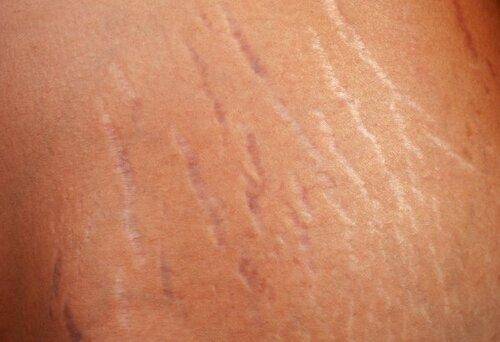
Stretch Mark Care During Pregnancy
Share

After nine months of our bodies’ growing to accommodate our babies, it is understandable that we may develop Striae Gravidarum also known as Stretch Marks. Stretch marks are basically small tears in the layers of tissue under your skin as it expands.
During pregnancy your hormones can soften the fibres of your skin, making it more prone to stretch marks. These indented streaks may appear on your tummy, boobs, and thighs as your skin is expanding quickly. You’ll most likely start to notice stretch marks around the end of the second trimester into the beginning of the third trimester however they do sometimes appear sooner.
Whether or not you get stretch marks has a lot to do with the elasticity of your skin as well as how rapidly your skin is expanding. The faster your skin stretches, the more likely it is to leave a mark. Stretch marks usually fade on their own over time. Although there isn’t a treatment that will get rid of stretch marks completely, there are things you can do to help reduce their appearance and texture. The results vary from person to person and depend largely on your genetics, diet, and lifestyle habits.
Here are some ways we can take care of our skin during pregnancy & postpartum
Eat a nutrient-rich diet
Though stretch marks are usually genetic, nourishing your skin from the inside can be a good defense against striae. Eating a well-balanced diet packed with vitamins, minerals, and antioxidants such as beta-carotene, vitamins C, E, and A and omega-3 helps in skin cell creation and collagen production, which helps keep skin strong and elastic.
EFAs (essential fatty acids). These consist of flaxseed oil, borage oil, blackcurrant seed oil, sunflower seed oil, blue-green algae etc. Polyunsaturated fat is prone to oxidation, which leads to rancidity and free-radical generation, so store your fats in the refrigerator and consume them in balance with your other foods.
Nuts and seeds (Brazil nuts, macadamias, almonds, walnuts, hemp seeds, sunflower seeds, chia seeds, pumpkin seeds, flaxseeds). The oils from nuts and seeds help to nourish the skin from the inside helping to increase skin elasticity.
incorporate foods such as berries, kale, spinach, colourful peppers, sweet potatoes, papayas, citrus fruits, broccoli, and carrots into your diet.
Foods high in zinc such as beef, seeds, lentils, cashews, turkey, quinoa, and prawns can also help with collagen production.
Exfoliate and Massage
Exfoliating your skin often can help to slowly remove the layers of damaged skin and encourage the regrowth of healthy tissue. Follow this up by massaging a stretch mark oil or cream on your belly, hips to the belly, hips, thighs, and breasts in a circular motion.
A daily massage can help to stimulate collagen production, boost blood circulation and improve skin’s tensile strength. Massage also connects you with your body, allowing you to appreciate your physical being even though you may not feel like looking at your reflection.
Use a hydrating, anti-inflammatory and antioxidant oil like our Nourishing Skin Oil, a specially formulated blend of deeply nourishing plant oils including Rosehip, Buriti, Baobab, and Murula Oils, to help build the skin's strength help keep it soft and supple during pregnancy so that it retains epidermal elasticity.
Be sure to massage the underside of the belly as that is the skin that tends to overstretch the quickest. Applying daily will help with the dry, itchy skin associated with pregnancy. This is best done in the evening after a shower, when your pores are still open.
Stay Hydrated
Drinking enough water throughout pregnancy ensures that your skin is staying well hydrated, keeping it soft and elastic. This keeps your skin supple and less prone to tears and helps to improve the overall appearance of your skin.
